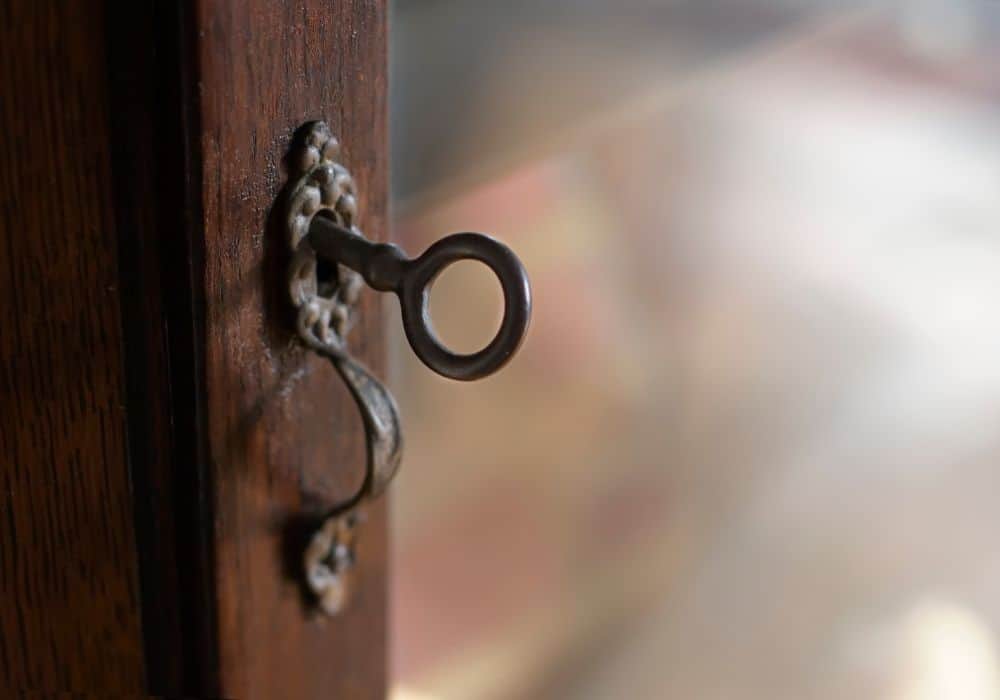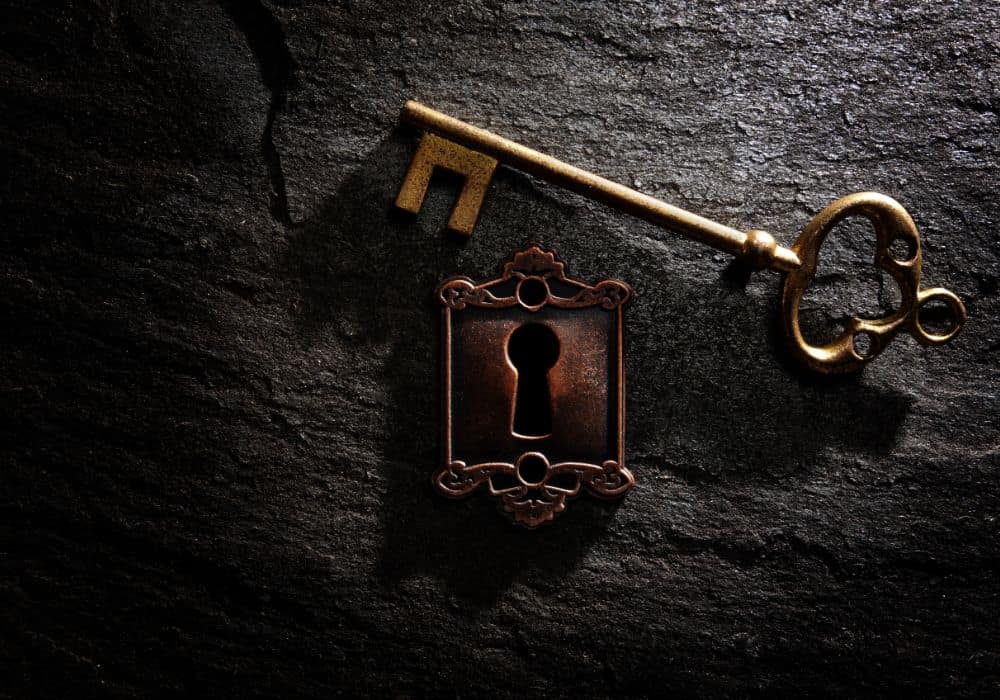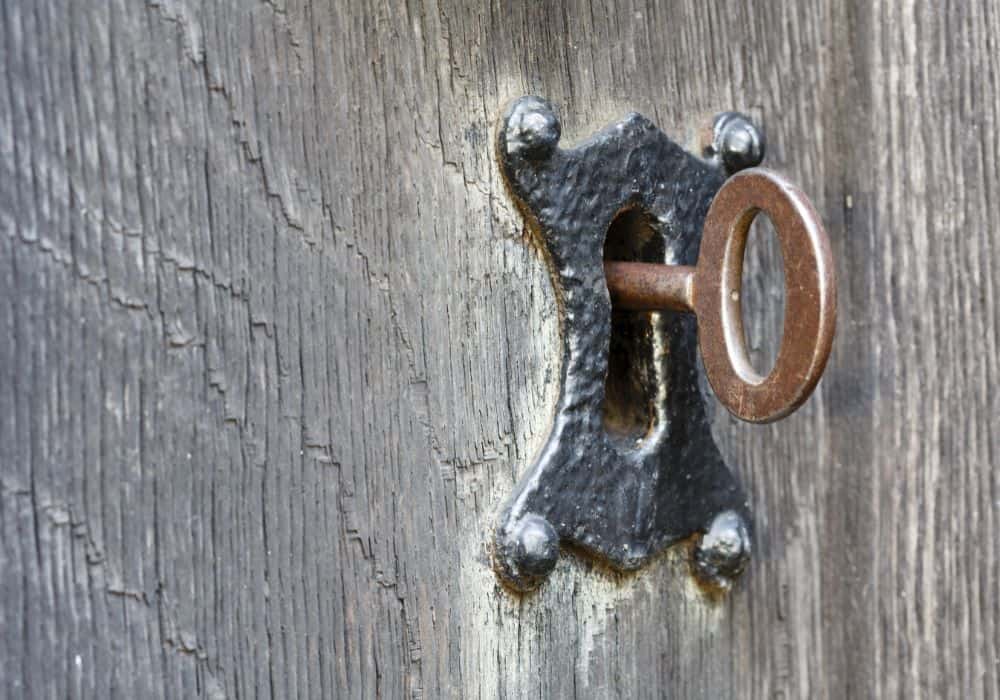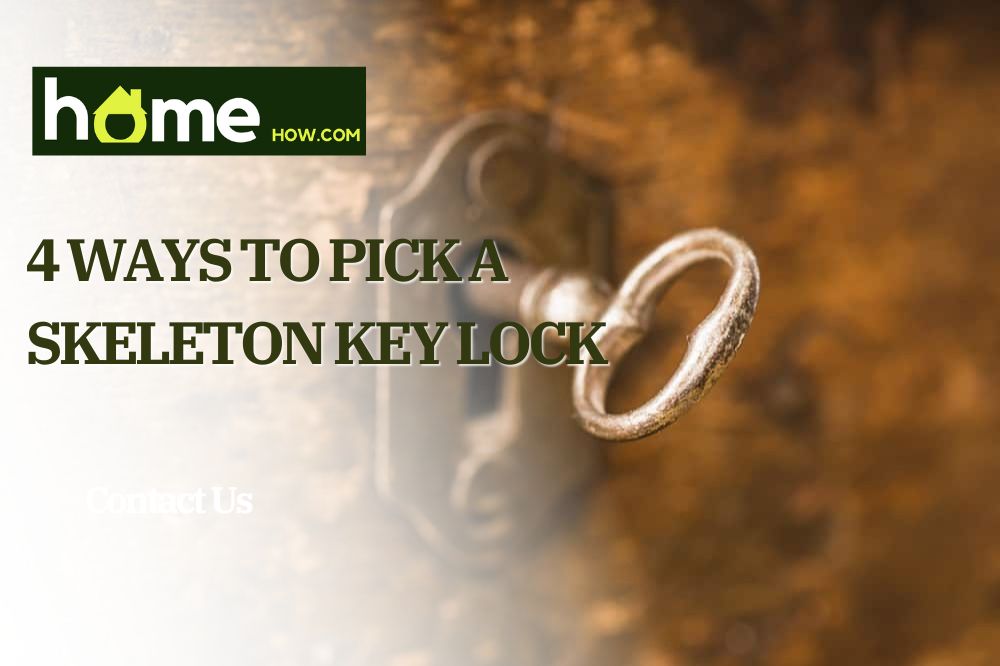Skeleton key locks have long been replaced by tubular and magnetic locks. But, every now and then, you will still run into one.
These old key locks are a common feature of antique furniture and homes. You’ll find them in cabinets, cupboards, doors, and whatnot. And, well, chances are the keys will be lost.
It’s why knowing how to pick a skeleton key lock is a must. So, without further ado, let’s explore this step-by-step guide on picking skeleton locks.
What Is a Skeleton Key Lock?
A skeleton key features a decorative bow, a narrow shaft, and an extension on the bottom called the tip. The extension faces one side and does not have any serrated edges like the modern-day keys.
The lack of serrated edges, coupled with a hollowed interior, makes the skeleton key versatile. It can be used to open several different types of locks. Typically, it is used with lever or warded locks.
1. Warded Locks
A warded or ward lock consists of a set of obstructions that prevents it from opening. Only the right key has the slots and edges that correspond to the obstructions. Hence, when inserted, the key rotates freely inside and opens the lock.
Skeleton keys for warded locks do not have interior notches. Instead, they’re completely hollow, which avoids interference with obstructions and makes opening the lock easy.
2. Lever Locks
A lever lock features multiple levers as obstructions inside the lock. So, when you insert the right key and rotate, the lock moves the individual levers into their correct position. This causes the lock to disengage and open.
Lever locks used for skeleton keys have a slightly different mechanism. In these locks, the key rotation pushes the levers to their appropriate heights. There might be wards inside some locks too.
It’s why skeleton keys for lever locks are designed to be specific. You can not use them with all locks, unlike most skeleton keys.
That said, a master skeleton key can be used to open all lever locks within a system. People in the past usually kept one master key along with regular ones to ensure there was a backup always available.
3. What’s the Difference Between Skeleton Key & Master Key?
Both the keys classify as skeleton keys. The mere difference between them is that a general skeleton key may or may not be versatile.
Most skeleton keys are designed to be compatible with different locks, like warded and lever locks. However, some variants may be specific as discussed in the case of lever locks.
Comparatively, a master key is always versatile. It is designed to work with all the locks within the system. For example, if a house has specific types of locks installed, its master key will be able to open all of them.
How to Pick a Skeleton Key Lock?

When a key is lost, there are two easy solutions that a person resorts to:
- Find a substitute key
- Break the lock
Unfortunately, things aren’t this simple for skeleton key locks. These locks are an old yet durable invention. It’s quite difficult to find a replacement key, and breaking the lock might require additional assistance.
The only other possible solution left is to pick the lock. If you’re new to lock picking, read the guide below carefully. We’ve broken down the process into small, easy steps for successful results.
Please note, the method to pick a skeleton key lock is the same for all types (warded and lever).
Method 1: Using Allen Wrench
For this method, you will require two Allen wrenches that are compatible with the skeleton key lock. It means the size should be the same because you’ll have to insert the Allen wrench into the keyhole. Usually, the 3/32-inch Allen wrench works well.
- Step 1: Insert the First Allen Wrench
Use the first Allen wrench to locate the lever inside the lock. Push it in the keyhole and wiggle it upwards. You should feel a slight resistance, which is the lever or ward.
Continue wiggling the Allen wrench in the lock to identify other obstructions. Move the wrench upwards, downwards, and sideways. In most cases, you’ll only feel something on the top.
However, if you feel nothing at all inside the lock, this means the springs are dysfunctional. Picking the lock won’t be possible, so you’ll have to call a professional.
- Step 2: Engage the Lever
Once identified, use the first Allen wrench to engage the lever and keep it in place. This might take a few attempts as the lever moves a lot inside the lock. Sometimes, it’s preferred to use your hands to engage the lever.
- Step 3: Insert the Second Allen Wrench
The lever engagement won’t stay in place on its own. You will have to keep it in the right position using the first Allen wrench and then insert the second one. These two metal rods will engage with the lever together, functioning like a key.
- Step 4: Rotate It Clockwise to Unlock
While keeping both the wrenches engaged, twist the second Allen wrench in a clockwise direction.
Don’t panic when you feel resistance, which will be from the deadbolt. Continue to twist until the deadbolt moves back. This will open the lock!
Now, remove the wrenches and twist the knob to open the door. If this doesn’t open the door, it means the springs of the handle are broken. You’ll require professional assistance to resolve the issue.
Method 2: Using Pliers & Paperclips
If you do not have Allen wrenches, you can repeat the same process using pliers and paper clips. Here’s how to do it:
- Use a plier to insert the paperclip into the keyhole of the skeleton lock.
- Wiggle it upwards, downwards, and sideways to feel the levers.
- Once identified, engage the paperclip with the lever to hold it in the position.
- Insert the second paper clip and engage both paper clips with the lever together.
- Rotate the second paperclip clockwise to unlock the deadbolt.
Important Notes

Having an Allen wrench or pliers is sufficient to open the skeleton key lock. But, it’s advisable to keep a bottle of lubricant and a pair of gloves to ease the process.
The lubricant will help remove the rust from antique locks. You can use both penetrating and dry lubricants available in the market. They’re cheap and efficient in performance.
Just pour a small quantity over the lock and wait for some time. The lubricant will infiltrate into the rusted buildups and loosen them. Oil is also a good substitute for commercial lubricants.
That said, do not use any lubricating agent without gloves. The greasiness can cause the tools to slip and damage your hands. Wear a thick pair of gloves to ensure safety and easy handling.
Is There Any Other Way to Open Skeleton Key Lock?

Apart from picking the lock, there are two more ways to open a skeleton lock without a key. These include:
Purchase a Replacement
You might not find a skeleton key lock replacement in the usual stores. These locks are hardly used in the present world. So, the best place to lock for a key replacement is an antique store.
These stores have a collection of old, discarded keys. You can sort them out to find the right one for your lock. However, be careful when dealing with antique and vintage items.
Many of these are highly valuable to the antique community. If they are aware of the key’s worth, they might demand hundreds and thousands of dollars. A cheaper alternative could be to search online platforms like eBay and Etsy.
There are several reproduction artists who sell old key replicas for a low value. You can also get a custom key designed specifically for your skeleton locks.
Hire a Professional Locksmith
If you wish to skip the trouble of picking locks and finding replacements, just call the local locksmith. A locksmith is an individual who specializes in making and repairing locks. However, they might charge high for antique skeleton locks.
FAQs
Are skeleton key locks easy to pick?
Yes, skeleton key locks are quite easy to pick and offer little security. It’s one of the primary reasons why people stopped using them.
What does the inside of a skeleton key lock look like?
The interior of a skeleton key lock depends on the type. A warded lock will have different obstructions, whereas a lever lock will have levers. Here’s a video to help you get a better insight:
Last Words
Picking a skeleton key lock is a fairly simple process. Here’s a quick recap of how to do it:
- Push the Allen wrench or paperclip inside the keyhole.
- Wiggle it in different directions to locate the lever. Usually, the resistance comes from upwards.
- Engage the wrench or paperclip with the lever and hold it in place.
- Insert the second Allen wrench or paperclip and engage it with the lever too.
- Rotate the second tool in a clockwise direction until the deadbolt unlocks.
- Remove and that’s it; open the door!
If you haven’t picked a lock before, follow this guide carefully and use lubricants or gloves to make things easier. We wish you all the best!
